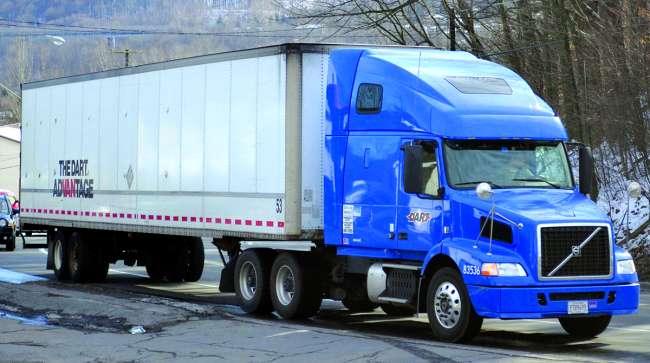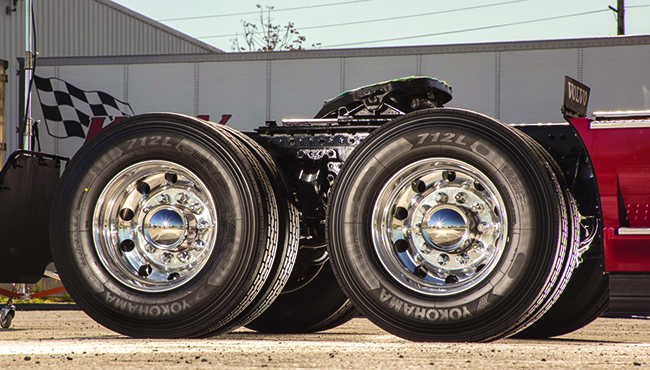Special to Transport Topics
Fleets Conduct Real-Life Tests Before Committing to New Tires

Improvements to truck tire technology in recent years have created a collection of products that manufacturers often tout as their most advanced, longest-wearing and most fuel-efficient tires ever. But many motor carriers choose to analyze those factory-tested claims in their own real-life settings before committing to adding the products to their entire fleet.
Despite manufacturers’ claims of tire fuel efficiency and cost savings, “we’re always going to have to prove it to ourselves,” said Brett Wacker, vice president of maintenance at Dart Transit Co. “We never want to be all-in on something without first testing it in our own environment.”
Fleets first need to determine specifically which tire performance elements to test.
“Is it durability? Is it wear? Is it mpg? Defining that is key,” said Joel Lalicker, maintenance manager at Pennsylvania-based PGT Trucking.

Wacker
Deciding what to test was a topic of discussion at a session on strategies for successful fleet tire testing in March at the Technology & Maintenance Council’s annual meeting in Atlanta.
Another element of fleet tire testing that was discussed is the strategy of using a minimum sample size of 30 tires per test. That entails having extra test tires on hand to ensure at least 30 remain in the end because tires could sustain damage unrelated to the testing, such as a puncture. Aiming for 30 tires at the test’s completion provides better statistical accuracy, according to TMC, which is a council of American Trucking Associations.
Many factors contribute to tires’ performance, such as weather, load weight and balancing, driver performance, wheel alignment and route terrain. Tire evaluations for fuel economy should take all those factors into account at a minimum, experts said.

Legler
It’s good for fleets to verify their own mileage, and it starts with properly spec’ing tires, said Jack Legler, technical director of TMC.
On a day-to-day basis, the tires and wheels “are probably the most important part” of properly optimizing transportation assets for efficient fuel consumption.
More efficient fuel consumption can lead to significant savings for a fleet’s bottom line. Attention to details when purchasing and maintaining tires “can cost you or make you a lot of money,” Legler said. “There are so many tires on vehicles, and so many vehicles in a fleet, that it adds up quickly.”
Tires are only one piece of the puzzle when it comes to fuel efficiency, said Daryl Bear, lead engineer and chief operating officer at Mesilla Valley Transportation Solutions, a provider of fuel economy testing services.

Read more feature stories from our second-quarter issue of Equipment & Maintenance Update:
Consultants can look at a carrier’s business holistically and identify other operating factors that play into tires’ fuel efficiency that could be tweaked. For instance, “adjusting engine parameters can improve tire wear, both in acceleration and deceleration, and save fleets money,” Bear said.
MVT Solutions is a subsidiary of Mesilla Valley Transportation, which ranks No. 72 on the Transport Topics Top 100 list of the largest for-hire carriers in North America.
Most fleets’ trucks also house onboard computer systems that provide data related to fuel efficiency. They can be programmed to monitor engine efficiencies and RPMs, and can deliver instant — or long-term — fuel consumption rates and transmission shifts, said Tom Clauer, senior manager of commercial and over-the-road product planning at Yokohama Tire Corp. “Others may install devices that can track the trucks by GPS and measure fuel usage and engine performance over a given distance.”

Yokohama works with fleets on the best tire options, a company representative says. (Yokohama Tire Corp.)
He said Yokohama works with fleets to choose the best possible tire options for them. “Some fleets may want fuel-efficiency as a priority, others mileage or traction.”
Testing tires in each fleet’s real-world operating environment is important because they can differ significantly from OEMs’ and other fleets’ testing environments, experts said. For example, a fleet based in the northern United States or Canada needs tires that perform well in cold, icy conditions, whereas one that operates primarily in warmer, southern climates would not have those considerations. If a northern fleet tests only during the summer, it might discover too late that certain tires are more prone to failure in inclement weather, causing managers to “spend money on towing, [and that] just blew every bit of savings you had on that tire,” said Dart Transit’s Wacker.
Dart Transit is a division of Dart Holding Co., which ranks No. 68 on the for-hire T100.
The importance of evaluating tires across multiple seasons is one reason fleets are encouraged to run tests over long periods of time. Summer is “the hardest time of year on tires,” PGT Trucking’s Lalicker said, so running a test beginning in April won’t produce results comparable to one beginning in August.

Lalicker
That highlights another procedure that is recommended for tire testing: having a control group. It’s important to make every effort to keep all other factors besides tire make and model constant across both the test and control group trucks, said Paul Mages, asset management analyst at Dart.
“You have to understand what you’re looking at,” he said, adding this includes “the whole life cycle of the tire.”
Fleets usually should expect to spend several months performing a single test to yield accurate results. True trends typically do not emerge during short time periods of a week or two, especially when looking for wear or fuel efficiency.
“Tire testing is generally not a fast turn,” Lalicker said. “It takes a lot of patience and discipline to get to the end of it and get the result.” The patience pays off because tire testing “can substantially help your cost position, but you have to do it the right way.”
Wacker recalled a time working for a different company when he “got burned young in my career when I went all-in on a new tire” by using too short of a testing period.
Being patient for about six months longer in the testing cycle before ordering new tires for a fleet of new trucks would have revealed that when the tire’s tread depth reached about 14/32 of an inch, “the shoulder edge couldn’t hold up,” he said. The fault occurred in nearly all the tires on a 400-truck order.
Wacker said he “went from saving the company a ton of money to costing it more.”
Even though TMC recommends a minimum of 30 tires for optimal statistical relevance, fleets of all sizes still can perform tests with meaningful results. Small fleets can test tires on just one truck, outfitting that vehicle with both the test and control tires. And fleets that would have a tough time performing a substantial test might lean on manufacturers a bit more, or seek third-party consultants for an analysis.

Bridgestone tires on display at the 2019 Technology & Maintenance Council annual meeting. (John Sommers II for Transport Topics)
A key reminder is that “there is never a substitute for proper tire maintenance,” said Robert Palmer, director of market sales engineering for Bridgestone Americas Tire Operations. “Proper tire care and inflation pressure maintenance are key contributors to a tire’s fuel efficiency.”
In addition to proper inflation pressure, he recommends regularly checking for cuts or bulges in the tire casing and irregular wear.
Some fleets use tire pressure monitoring and automatic inflation systems to help ensure their tires are properly inflated.
“Tire inflation systems pay off quickly,” TMC’s Legler said. Tire pressure can change dramatically in short periods of time due to factors such as temperature, but automatic inflation systems keep the pressure consistent by detecting even subtle changes. That plays into a tire’s rolling resistance and fuel economy, he said.
Although fuel efficiency testing proves beneficial for all types of tires, certain tire positions are more difficult to accurately assess. For instance, trailer tires are more difficult to analyze than those on a tractor because while tractors are used daily, trailers get switched out frequently and might sit for long periods of time. That’s not conducive to consistently gathering data in an ongoing analysis, experts said.
In addition, one trailer might sit longer than others, eliminating the consistency among test and control groups. Therefore, testing trailers is more successful with larger sample sizes, and fleets have to “make some assumptions on the trailer side,” Dart’s Mages said.
Still, trailer tires tend to be more fuel efficient.

Bear
“The type of tread very much affects fuel consumption,” Mesilla Valley’s Bear said. “In general, a trailer tire is more efficient because its tread pattern is ribbed instead of having lugs.”
Retreads can be tested for the same outcomes as virgin rubber, but again, the test must be set up correctly to garner meaningful results. A fleet testing recaps should only use recap control tires.
“You don’t want to mix it all up,” Lalicker said, “because you don’t want to pollute the results.”
Similarly, strategically considering tire placement during testing affects outcomes because of the repeated stresses that certain axles and tire positions sustain. Putting all the test tires on the right side of the truck might cause them to undergo more stress or contact with the road shoulder, thus skewing results. Industry participants recommend cross-pattern testing, in which two test tires are placed on the right front and left rear, with control tires on the left front and right rear.
Regardless of how fleets prefer to go about testing, it pays off for them to know how all tires perform for fuel economy, Bear said. “There’s a lot of fuel savings opportunities with tires and it’s worth their time to investigate it.”




